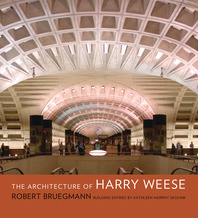
The Architecture of Harry Weese
26 October 2010
Territory Rights — Worldwide.
Description
This study tells the story of one of America’s most gifted architects of the postwar years.
During a career that spanned half a century from the 1930s to the 1980s, Weese produced a large number of significant designs ranging from small but highly inventive houses to large urban scale commissions like the Washington, D.C., Metro system. Although influenced to some degree by the rational, and often austere, work of European modernists like Mies van der Rohe, in most of his own oeuvre Weese instead followed the example of Nordic architects like Gunnar Asplund and Alvar Aalto in favoring natural materials, human scale, and comfort; his work was characterized by a deep respect for older buildings and existing urban patterns and a fondness for unexpected, often idiosyncratic design decisions.
This book takes its place within a fast-growing revival of interest in the work of Weese and a number of his friends and contemporaries with shared assumptions and sensibilities, notably Eero Saarinen, Edward Larrabee Barnes, I. M. Pei, Ralph Rapson, and Paul Rudolph. As important as Weese’s buildings were, though, they were only one part of what almost all his contemporaries recognized as his seemingly inexhaustible creativity. Because Weese believed that design was essentially problem-solving, he was willing to apply his skills to everything from a piece of furniture to an entire city. The city on which he lavished the most attention was his own city, Chicago, where he seemed to be everywhere at once, praising, criticizing, cheerleading, and pouring out ideas for creating a humane and livable place for citizens of all walks of life.
Reviews
"[T]his wonderful book by Robert Bruegmann illustrates [that Weese] was an inventive and thoughtful humanist, concerned as much with how people used and perceived his spaces as their aesthetic implications for other architects. . . . The book is candid in its discussion of this tremendously talented man and both his successes and shortcomings." — Life of an Architect
"[P]rovides a thorough and insightful account of the wide-range career of an amazingly multifaceted architect, which is long overdue." — DOCOMOMO
"[T]his is not the usual hagiographic posthumous monograph. But it does reveal Weese’s protean talent for manipulating forms, angling views and windows in unpredictable ways, and respecting and reinterpreting the past." — Architect
"This book is worth reading for any architecture buff who is not only intrigued with large public projects…but also with innovative modern residential design." — DC by Design
"This book paints an astonishingly full picture of a very gifted, extremely prolific, but, until recently largely unknown American architect. Bruegmann has carefully researched Weese's life and he tells a story which could be regarded as essential reading for anyone setting out on a life in architecture.... [T]he sheer amount and quality of work produced by Weese is extraordinary and his contribution to the built environment in America and beyond is very significant. Time spent reading Bruegmann's sensitive story and pouring over Skolnik's beautiful catalogue will be time well spent." — RIAS Quarterly


